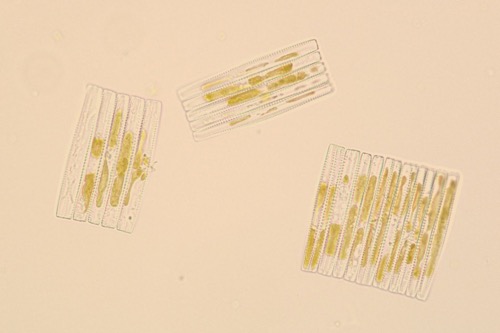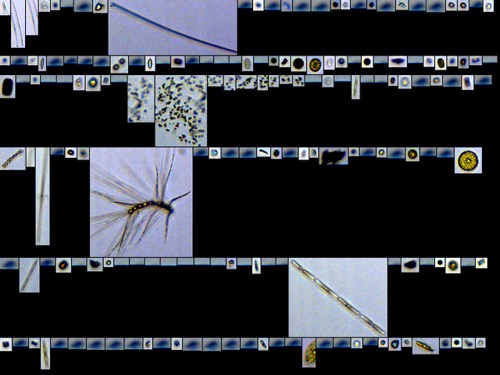Thanks for Waiting
We officially moved onto the RVIB Nathaniel B. Palmer one week ago and we have already sampled ocean water for our first incubation. You have been patient with me as I explained the use of the FlowCam, learned how to sample nutrients and walked you through the requirements for trace metal clean procedures and incubations. I have also told you about the rough seas, long hours and cold temperatures that go along with this type of oceanographic research. I would not be surprised if you have asked yourself why researchers go through these extensive steps and travel to these extreme conditions to study microscopic organisms. I think you have waited long enough to hear about the star of the show.
Guest Writer - Alexa Sterling
Alexa Sterling from the University of Rhode Island (who you have seen featured in previous journals) is going to tell you a little about diatoms.

Dynamic DiatomsDiatoms are one of the most common types of phytoplankton. Most diatoms are unicellular, although they can exist as colonies in the shape of filaments or ribbons. Diatom communities are a popular tool for monitoring environmental conditions, past and present, and are commonly used in studies of water quality.
DiatomsDiatoms are one of the most common types of phytoplankton. Most diatoms are unicellular, although they can exist as colonies in the shape of filaments or ribbons. Diatom communities are a popular tool for monitoring environmental conditions, past and present, and are commonly used in studies of water quality. are an important group within the marine plankton and they are found in all the world’s oceans. These microscopic organisms depend on photosynthesis for their source of nutrition, by converting carbon dioxide, water, and the sun’s energy into oxygen and food (stored energy).

Because of this, diatoms make up the base of the food web as primary producers. They play a similar role in the oceans as plants play on land by being a tasty meal for many animals. In the Southern Ocean, diatoms feed many animals ranging from tiny krill (small shrimp-like crustaceans) to huge filter-feeding whales, like minke and humpbacks. Even their oxygen production is important because they provide us every 5th breath we take!

DiatomsDiatoms are one of the most common types of phytoplankton. Most diatoms are unicellular, although they can exist as colonies in the shape of filaments or ribbons. Diatom communities are a popular tool for monitoring environmental conditions, past and present, and are commonly used in studies of water quality. are a type of phytoplankton, or marine plankton that photosynthesize. PlanktonPlankton are small or microscopic organisms that float or drift in fresh or salt water, especially at or near the surface, and serve as food for fish and other larger organisms. drift along with the water currents as they are unable to actively swim. DiatomsDiatoms are one of the most common types of phytoplankton. Most diatoms are unicellular, although they can exist as colonies in the shape of filaments or ribbons. Diatom communities are a popular tool for monitoring environmental conditions, past and present, and are commonly used in studies of water quality. have special adaptations that help control their water depth without having to swim. It is important for diatoms to be in the part of the ocean that receives sunlight (photic zone) in order to photosynthesize. When the conditions such as light, water temperature, and others are particularly good, diatoms can reproduce rapidly forming blooms.
Tiny Creatures
There are about 14,000 – 18,000 different species of diatoms alive in the ocean today! All are unicellular, meaning that they are only made of one cell. Everything they need to survive is provided within that one cell: chloroplasts for photosynthesis, stored food energy, structures for reproduction, protection from predators, etc. They range in size from 2 um (micron) to 2 mm. Read the caption below the ruler picture to learn more about the size of a micron.

We need microscopes to see individual diatoms, but we can see a brown-green tinge to our filtered water samples. This color is from pigments in their photosynthetic chloroplasts letting us know there are phytoplankton in the sample. As you can see from the pictures of diatoms below, they can look drastically different from one another, but there are similarities. For instance, all diatoms live in “glass houses". Their cell wall is made of silica which is called a frustule. It fits together like a Petri dish, with one half larger than the other. There are two main shapes of the frustule: centric and pennate. Centric diatoms are circular while pennate diatoms are boat-shaped. Can you see examples of these two shapes in the pictures below?


Their frustules can have interesting unique features, and diatoms have been compared to works of art. Frustules may have spines, ridges, setae (hair-like extensions), and pore (hole) patterns. These distinguishing features help us tell different species apart. They also serve as useful adaptations in the challenging ocean environment. Spines can help increase the diatom’s buoyancy helping it float in the photic zone and not sink. Setae are long hair-like extensions that make it difficult for predators with small mouths like krill to eat them. Can you find examples of these characteristics in the diatom pictures?
DiatomsDiatoms are one of the most common types of phytoplankton. Most diatoms are unicellular, although they can exist as colonies in the shape of filaments or ribbons. Diatom communities are a popular tool for monitoring environmental conditions, past and present, and are commonly used in studies of water quality. may be individual solidary cells, but often they are found connected together living in colonies. Colonies are made of diatoms of the same species. Colony formation is another adaptation that prevents predation by making the cells too large for a krill to eat. DiatomsDiatoms are one of the most common types of phytoplankton. Most diatoms are unicellular, although they can exist as colonies in the shape of filaments or ribbons. Diatom communities are a popular tool for monitoring environmental conditions, past and present, and are commonly used in studies of water quality. can also attach to other surfaces in their marine environment. For example in the Southern Ocean, there are sea-ice diatoms which attach themselves to floating sea ice using mucus they produce. Just like looking at the filtered sea water, we know they are attached to the sea ice by the brown-green color of their pigments. We will be collecting sea-ice diatoms during this cruise.
Microbiology Vocabulary
You may have noticed many bold vocabulary words in this journal. Keeps your eyes peeled for many more vocabulary words as we start to find out what the scientist are doing with all of these dynamic diatoms!


Comments
Pagination